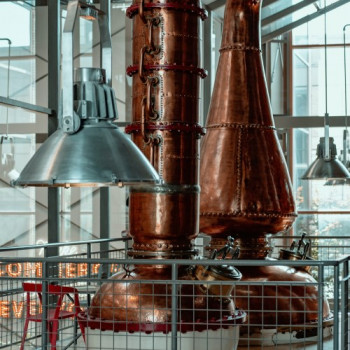WHISKY'S DISTILLATION PROCESS


The distillation process involves heating a liquid to its boiling point, collecting the resulting vapor, and condensing it back into a liquid. This process is commonly used in the production of alcoholic beverages such as whisky, gin, and vodka. One type of still used in this process is the column still.
A column still is composed of two interconnected columns: the analyser and rectifier, which work together to increase the alcoholic strength and influence the character of the distilled spirit. The column still is usually made of stainless steel and can reach up to 25m (82ft) in height, equipped with a series of perforated plates made of either stainless steel or copper.
The rectifier continues the work of the analyser with greater precision, utilizing around 45 evenly spaced plates where changes in the alcoholic strength between neighboring plates are not uniform. In the lower section of the rectifier, the alcoholic strength of the vapors rises by 5-10 percent ABV from one plate to the next. As the vapors ascend, the increase becomes much smaller, around 0.1-0.2 percent ABV. The temperature is hotter at the base of the rectifier, around 120°C (248°F), and becomes progressively colder higher up the column, around 90°C (194°F).
The temperature is significant as different flavor compounds have their specific boiling point. Lighter flavor compounds, such as certain esters, evaporate and remain in vapor form at cooler temperatures than richer flavor compounds, such as some cereal notes, which require hotter temperatures to evaporate and remain in vapor form. As vapors ascend and experience progressively lower temperatures, certain flavor compounds condense on a particular plate, resulting in the proportion of lighter and richer flavors in the vapors continually changing.

The distiller can choose the desired plate for spirit with the desired characteristics and alcoholic strength. The spirit is drawn from this plate and conducted through a pipe to a vessel called a spirit receiver.
Several factors influence the spirit's character, including the number of plates, dimensions of the still, distillation rate, and the alcoholic strength at which the spirit is drawn off. The distillation rate determines the amount of contact vapors have with copper, which is vital in the distillation process. The level of heat applied to the charge determines the distillation rate, which can be adjusted by turning a lever to suit the level of copper contact required.
Source: The Whisky Dictionary: an A-Z of Whisky, from history & heritage to-distilling & drinking



